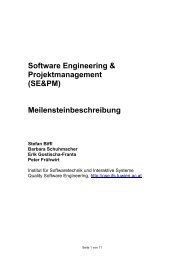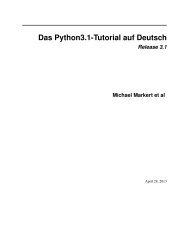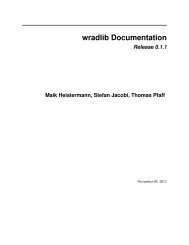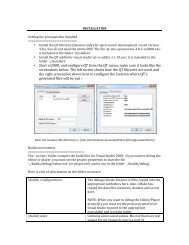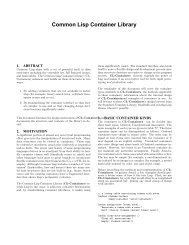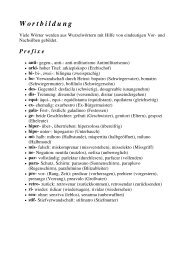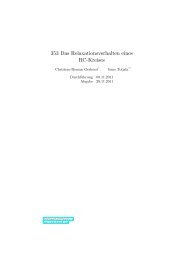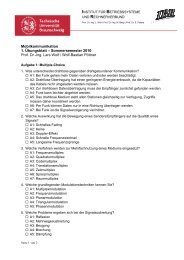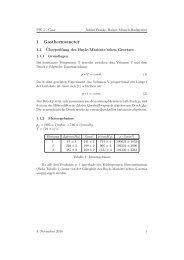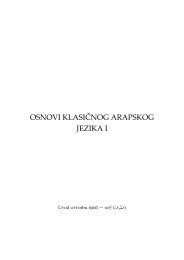P-Technique Demonstrated in Determining ... - Bitbucket
P-Technique Demonstrated in Determining ... - Bitbucket
P-Technique Demonstrated in Determining ... - Bitbucket
Create successful ePaper yourself
Turn your PDF publications into a flip-book with our unique Google optimized e-Paper software.
RAYMOND B. CATTELL, A. K. S. CATTELL~ AND R. M. RHYMER 275<br />
ployed three different mnemonics at different times. The correlations<br />
both for memoriz<strong>in</strong>g and for ratio of emotional to non-emotiop~l<br />
words recalled were, however, so consistent with respect to the factor<br />
pattern which appeared later that we discounted the subject's impressions<br />
and <strong>in</strong>cluded it (by a secondary calculation from its correlations<br />
with highly loaded items <strong>in</strong> each factor. These were very consistent,<br />
but the load<strong>in</strong>gs for these two items are naturally approximate).<br />
Factor I. Emotional Abundance vs Emotional Dewrth. ~ This<br />
loads high sway suggestibility and high P.G.R. deflection decidedly;<br />
and also, less highly, ratio of emotional to non-emotional recall, and<br />
upward drift on P.G.R. and frequency of deflections. It has no relation<br />
to time of day or sequence of experiments. Through these runs<br />
an emotional responsiveness to environment which might almost be<br />
called a dynamic vigor or read<strong>in</strong>ess, were it not that sway suggestibility<br />
has been connected <strong>in</strong> the past with the more neurotic forms<br />
of emotionality.<br />
Factor H. Physiological Ease vs Emergency Alertness.--Loads<br />
slow reaction time, salivary alkal<strong>in</strong>ity, slow reversible perspective<br />
and, less clearly, poor memoriz<strong>in</strong>g, high ratio emotional to unemotional<br />
recall, low rigidity, and high ratio of regular to irregular<br />
warned reaction time. These variables are consistently and appreciably<br />
all negatively related to sequence of experiments, i.e., to practice.<br />
Favtor III. Fatigue vs Energy Reserve. -- Loads time of day,<br />
quickness of reversible perspective, frequency of P.G.R. deflection,<br />
magnitude upward resistance drift dur<strong>in</strong>g relaxation, and ratio of<br />
warned to unwarned reaction time. Except for the slightness of<br />
perseveration-rigidity load<strong>in</strong>g (which, however, reaches significance<br />
<strong>in</strong> some rotations) these tests comprise known tests of fatigue and the<br />
factor is clearly one of diurnal fatigue.<br />
Factor IV.bUncontrol vs Inhibition. This loads Fluency, Perseveration-Rigidity,<br />
large movements <strong>in</strong> myok<strong>in</strong>esis and, less def<strong>in</strong>itely,<br />
good memoriz<strong>in</strong>g, sway suggestibility, and P.G.R. Deflection. This<br />
factor is correlated positively with lateness of experiment sequence,<br />
but less so than II. S<strong>in</strong>ce rigidity (9), fluency (8) and sway suggestibility<br />
(13) have all <strong>in</strong>dependently been regarded as expressions of<br />
lack of <strong>in</strong>tegration and will (while large careless movements have the<br />
same character) it seems that this is def<strong>in</strong>itely some k<strong>in</strong>d of lack of<br />
<strong>in</strong>hibition, with greater spontaneity and carelessness.<br />
The factorization which yielded these factors was <strong>in</strong>tr<strong>in</strong>sically<br />
very satisfactory, first <strong>in</strong> that both McNemar's and Tucker's criteria<br />
showed def<strong>in</strong>itely four factors, second <strong>in</strong> that the simple structure



